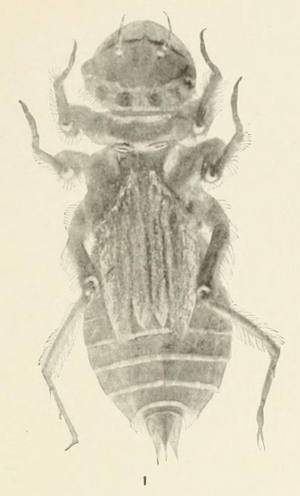Flame skimmer facts for kids
Quick facts for kids Flame skimmer |
|
|---|---|
 |
|
| Male dragonfly | |
| Scientific classification | |
| Kingdom: | |
| Phylum: | |
| Class: | |
| Order: | |
| Suborder: | |
| Family: |
Libellulidae
|
| Genus: |
Libellula
|
| Species: |
L. saturata
|
| Binomial name | |
| Libellula saturata Uhler, 1857
|
|
The flame skimmer (Libellula saturata) is a bright red or orange dragonfly. It is also sometimes called the firecracker skimmer. You can often find these beautiful insects in western North America. They belong to a family of dragonflies called Libellulidae.
Contents
What Do Flame Skimmers Look Like?
Male flame skimmers are famous for their bright red or dark orange bodies. Even their eyes, legs, and the tiny veins in their wings are this color! Female flame skimmers usually look different. They are often a medium or dark brown. They might have some thin, yellow stripes or spots on their bodies.
Flame skimmers can be different sizes. Most of them are about two to three inches long. Baby flame skimmers, called naiads, look a bit chubby. This is because they have a rounded body. They are covered in tiny hairs. Unlike many other young dragonflies, they do not have hooks or spines.
Where Do Flame Skimmers Live?
Flame skimmers love warm places. They often live near warm ponds, streams, or even hot springs. Because of this, you will mostly find them in the southwestern part of the United States. They also like to make their homes in public gardens or even in people's backyards.
What Do Flame Skimmers Eat?
Young flame skimmers, called nymphs, live in the water. They mostly eat other small water insects. Their diet includes things like mosquito larvae, tiny water fly larvae, and mayfly larvae. They also eat small freshwater shrimp, tiny fish, and tadpoles.
These nymphs live in the mud at the bottom of warm streams or ponds. They are very patient hunters. They wait quietly for their food to swim by.
Adult flame skimmers fly around in the air. They usually eat moths, flies, ants, or any other soft-bodied insect. They might catch their food while sitting on a small rock or twig. Sometimes, they catch insects while flying through the air.
How Do Flame Skimmers Reproduce?
Flame skimmers breed during their flight season. This usually happens from May to September. Male flame skimmers will compete with each other. They want to find the best places to breed and attract females.
After a male and female mate, they separate. The female then flies off by herself to lay her eggs. She does this by hovering over small streams or ponds. She dips the end of her body into the water to drop her eggs. Often, she lays her eggs in many different spots. This helps to make sure that the baby dragonflies do not eat each other when they hatch!
Images for kids
See also
 In Spanish: Libélula rayadora neón para niños
In Spanish: Libélula rayadora neón para niños







